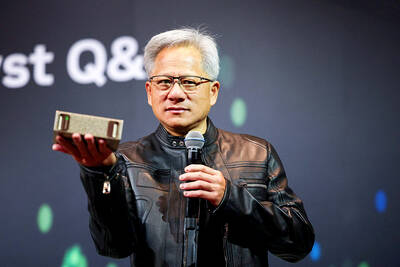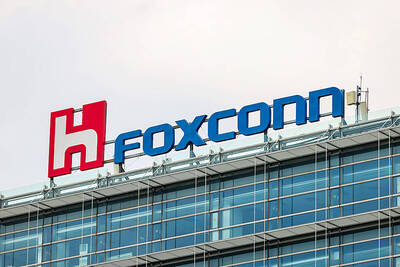State-run Hua Nan Financial Holding Co (華南金控) aims to boost its profit margin this year by diversifying its sources of income and achieving a higher capital utilization rate.
The bank-focused conglomerate said it intends to step up lending operations for small and medium-sized enterprises (SMEs), which could account for 70 percent of its loan book and raise the bank’ s interest rate spread.
“Hua Nan Financial will shore up its legal compliance system and capital utilization rates this year, while pressing ahead with efforts to support firms in the five-plus two sectors,” chairman Wu Tang-chieh (吳當傑) told a news conference.
Hua Nan Commercial Bank (華南銀行), the holding firm’s main subsidiary and source of income, is to increase loans to the “five plus two” industries by NT$15 billion (US$512.12 million), in line with the Cabinet’s plan to stimulate local development of an “Asian Silicon Valley,” and “smart” machinery, “green” energy, biomedicine and defense industries, as well as a new agricultural business model and a circular economy.
The lender has built a clientele list of 8,000 in those sectors, with a total of NT$400 billion in outstanding loans in December last year, Wu said, adding that loans to firms involved in “green” energy development amounted to NT$76 billion.
Hua Nan Bank would refrain from loan book expansion, but would seek to widen interest spread by 6 basis points this year, from an average of 1.4 percent last year, the bank executive vice president Jonathan Huang (黃俊智) said.
Net interest income, a critical gauge of banks’ profitability, hovered around 1.07 percent last year, he said.
The focus on SMEs and overseas operations would help expand the margin following interest rate hikes in the US and other countries, he said.
The lender is looking at a 5 percent increase in SME lending from NT$400 billion, company data showed.
The bank of 180 branches would keep mortgage operations flat this year, as the local property market has yet to come out of price correction pressures, although transactions have improved, Huang said.
Overall, the financial holding reported a net income of NT$12.09 billion last year, or earnings per share of NT$1.09. The showing represented a 14.29 percent decline from NT$14.09 billion recorded in 2016.
The company’s banking arm took part in the syndicated loan of NT$20.5 billion to troubled Ching Fu Shipbuilding Co (慶富造船) and booked a bad loan of NT$1.7 billion.
The lender last year wrote down additional bad debt of NT$2 billion linked to TransAsia Airways Corp (復興航空), but could recover some of the debt this year after the company found buyers for its aircraft.

SEEKING CLARITY: Washington should not adopt measures that create uncertainties for ‘existing semiconductor investments,’ TSMC said referring to its US$165 billion in the US Taiwan Semiconductor Manufacturing Co (TSMC, 台積電) told the US that any future tariffs on Taiwanese semiconductors could reduce demand for chips and derail its pledge to increase its investment in Arizona. “New import restrictions could jeopardize current US leadership in the competitive technology industry and create uncertainties for many committed semiconductor capital projects in the US, including TSMC Arizona’s significant investment plan in Phoenix,” the chipmaker wrote in a letter to the US Department of Commerce. TSMC issued the warning in response to a solicitation for comments by the department on a possible tariff on semiconductor imports by US President Donald Trump’s

‘FAILED EXPORT CONTROLS’: Jensen Huang said that Washington should maximize the speed of AI diffusion, because not doing so would give competitors an advantage Nvidia Corp cofounder and chief executive officer Jensen Huang (黃仁勳) yesterday criticized the US government’s restrictions on exports of artificial intelligence (AI) chips to China, saying that the policy was a failure and would only spur China to accelerate AI development. The export controls gave China the spirit, motivation and government support to accelerate AI development, Huang told reporters at the Computex trade show in Taipei. The competition in China is already intense, given its strong software capabilities, extensive technology ecosystems and work efficiency, he said. “All in all, the export controls were a failure. The facts would suggest it,” he said. “The US

The government has launched a three-pronged strategy to attract local and international talent, aiming to position Taiwan as a new global hub following Nvidia Corp’s announcement that it has chosen Taipei as the site of its Taiwan headquarters. Nvidia cofounder and CEO Jensen Huang (黃仁勳) on Monday last week announced during his keynote speech at the Computex trade show in Taipei that the Nvidia Constellation, the company’s planned Taiwan headquarters, would be located in the Beitou-Shilin Technology Park (北投士林科技園區) in Taipei. Huang’s decision to establish a base in Taiwan is “primarily due to Taiwan’s talent pool and its strength in the semiconductor

French President Emmanuel Macron has expressed gratitude to Hon Hai Precision Industry Co (鴻海精密) for its plan to invest approximately 250 million euros (US$278 million) in a joint venture in France focused on the semiconductor and space industries. On his official X account on Tuesday, Macron thanked Hon Hai, also known globally as Foxconn Technology Group (富士康科技集團), for its investment projects announced at Choose France, a flagship economic summit held on Monday to attract foreign investment. In the post, Macron included a GIF displaying the national flag of the Republic of China (Taiwan), as he did for other foreign investors, including China-based